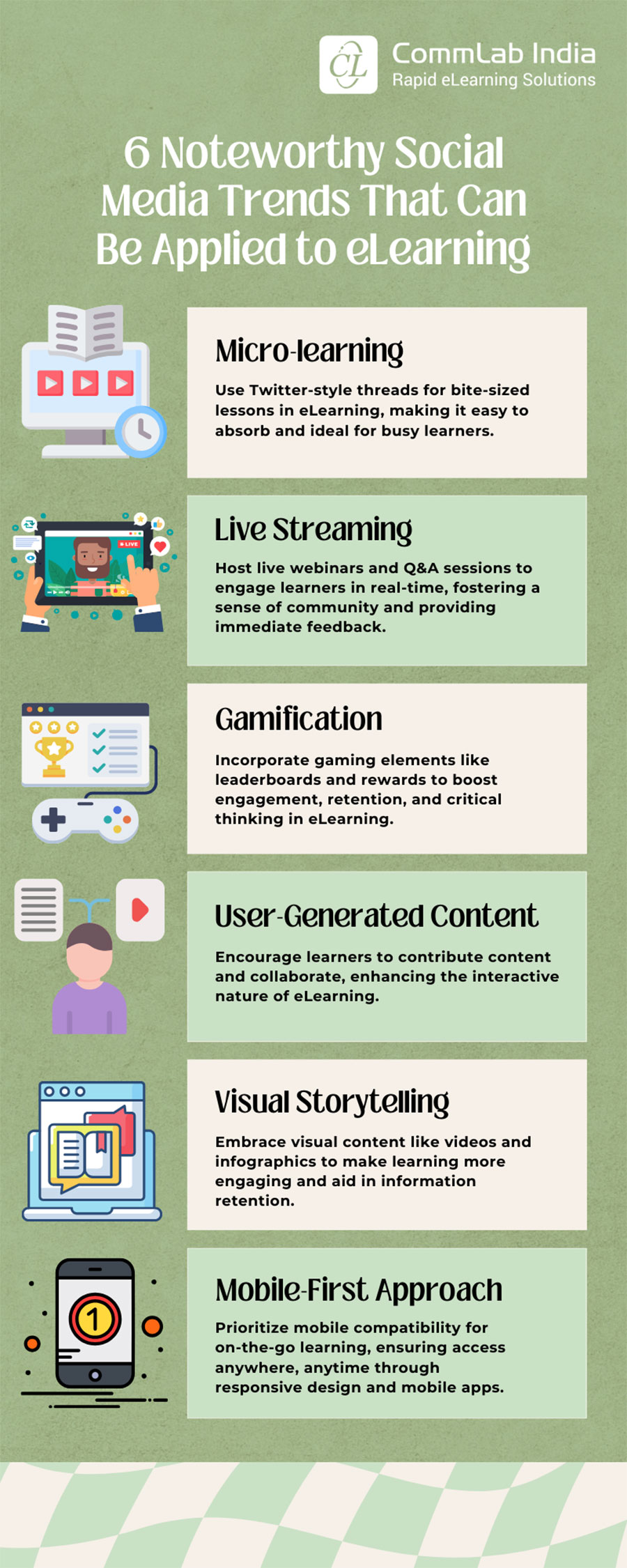Riding the Wave: How Social Media Trends Revolutionize eLearning [Infographic]
![Riding the Wave: How Social Media Trends Revolutionize eLearning [Infographic] Riding the Wave: How Social Media Trends Revolutionize eLearning [Infographic]](https://blog.commlabindia.com/hubfs/blogs/social-media-trends-elearning.jpg)
Incorporating the latest social media trends can enhance eLearning in many ways. For instance, microlearning offers short and easily digestible content that can be delivered through platforms such as Instagram and Twitter. Gamification, which involves rewards, badges, and leaderboards, can make learning more enjoyable and engaging. Collaborative learning can be facilitated through social media platforms, and video-based learning can also be incorporated to boost engagement.
→ Download eBook Now: eLearning Trends 2023
Additionally, eLearning courses can be designed to be mobile-friendly, catering to learners who prefer to learn on the go. Personalization can also be achieved by using algorithms to tailor content to learners' interests. Overall, integrating social media trends into eLearning can make learning interactive, engaging, and effective. Here is a comprehensive infographic that enlists a few popular social media trends that can be applied to eLearning seamlessly, and enhance its effectiveness and engagement.
Benefits of Applying Social Media Trends to eLearning
1. Enhanced Engagement
Social media trends make eLearning more engaging and interactive. Learners are more likely to participate actively when they encounter features they are familiar with from their social media experiences, such as videos, live streams, and gamified elements.
2. Improved Retention
Microlearning and visual storytelling help learners absorb and retain information more effectively. Bite-sized content and engaging visuals make complex topics more manageable and memorable.
3. Personalized Learning
Social media trends like personalization and recommendation systems allow eLearning platforms to tailor content to individual learner preferences and needs. This personal touch ensures that learners receive content that is relevant to them, increasing their motivation and learning outcomes.
4. Flexibility and Convenience:
The mobile-first approach ensures that learners can access training content from anywhere, at any time, using their smartphones or tablets. This flexibility aligns with modern learners' busy schedules and diverse learning environments.
5. Real-time Interaction
Live streaming and live Q&A sessions provide opportunities for real-time interaction between learners and instructors. Learners can ask questions, seek clarification, and engage in discussions, enhancing their understanding of the subject matter.
6. Motivation and Gamification
Gamification elements like badges, leaderboards, and rewards motivate learners to complete courses and stay committed to their organizational goals. This increased motivation can lead to higher course completion rates.
7. Competitive Advantage
As the eLearning landscape evolves, staying up-to-date with social media trends can give businesses and eLearning providers a competitive edge. Offering a more engaging and contemporary learning experience can attract and retain learners.
8. Adaptation to Modern Learning Styles
Today's learners are often accustomed to consuming content through social media platforms. Adapting eLearning to match these learning styles makes it more accessible and relatable to the current generation of learners.
Wrapping Up!
Applying social media trends to eLearning is essential for keeping training relevant, engaging, and effective in the digital age. By leveraging these trends, organizations can create a more dynamic and personalized learning experience that caters to the needs and expectations of modern learners. If you want to explore more eLearning trends in general, here’s an eBook you should download right now!





![Key Applications of Mobile Learning [Infographic]](https://blog.commlabindia.com/hubfs/Imported_Blog_Media/decoding-mobile-learning-guide-2.jpg)
![Effective Translation of E-learning Courses – 4 Tips [Infographic]](https://blog.commlabindia.com/hubfs/Imported_Blog_Media/translation-of-elearning-courses-4-tips-infographic1.png)
![3 Ways that MOODLE LMS Helps Impart Effective Product Sales Training [Infographic]](https://blog.commlabindia.com/hubfs/Imported_Blog_Media/sales-training-via-micro-learning.png)